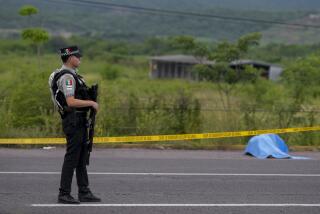COLUMN LEFT : What Are the Contras Up to Now? : A decision not to demobilize has Washington’s prints all over it.
- Share via
The Contra leaders in Nicaragua are now claiming that it was the recent strike by Sandinista civil service employees that caused them to halt the demobilization and keep at least 10,000 Contras under arms. Government workers rebelled against incoming President Violeta Barrios de Chamorro’s savage austerity measure to crush the public service sector unions and there is even some evidence that the Sandinista leadership, palavering with Chamorro, was taken aback by the militancy of the workers.
But anyone believing that until the strike the Contras were prepared to lay down their arms is misreading the brutal political hand that the United States is continuing to play out in Nicaragua.
The benign interpretation of current White House policy is that the United Nicaraguan Opposition’s electoral victory of Feb. 25 closed the books on U.S. sponsorship of the Contras. All that remained was the arrangement of a brisk schedule for their demobilization and re-entry into civilian society. Operating within these rosy assumptions, the American press reported last week the solemn assertions of government officials that $30 million of the funds President Bush is seeking for Nicaragua should be earmarked for the Contras. Otherwise, they might break out of their camps to “forage” for themselves and their families.
The premise here is that U.S. policy is essentially one of encouraging “reconciliation” in Nicaragua, with the Sandinista army remaining in place but gradually dwindling in size.
There is as little reason to believe this premise as there was in trusting that President Reagan would respect the Boland Amendment of 1984 (which cut off military aid to the Contras) or that Bush would honor the bipartisan accord of April, 1989 (which promised that in return for humanitarian aid, there would be no further Contra attacks).
What the Nicaraguan election in fact prompted was a U.S.-backed Contra invasion. More than 10,000 armed Contras crossed back into Nicaragua from Honduras in the aftermath of the Chamorro government’s victory. But the mainstream American press has been almost entirely silent about what these Contras have been up to. Less tactful observers, like the courageous members of Witness for Peace, have been sending north a stream of detailed reports of Contra outrages: the terrorizing and kidnaping of peasants, burning of agricultural cooperatives, destruction of equipment and supplies. To take just one example: On April 28, more than 600 Contras devastated the co-op at Mancotal, destroying and stealing everything in their path and vowing that the land would be returned to its former owners.
These reports also stress that the marauding Contras are freshly uniformed and armed. So who armed them? The lack of curiosity on this important matter is extraordinary and the answer is obvious.
The Contras have not laid down their arms to any substantive degree, and the United States is making no effort to pressure them to do so. On Monday, an Irish army officer just back from the United Nations force in Nicaragua said that in the security zone on the border with Honduras, only 19 Contras out of more that 4,500 had disarmed before he went on leave.
The U.S. claim that the Contras need another $30 million to prevent them from having to “forage”--that is, terrorize co-ops--is not credible. As with the humanitarian aid last year, the money is required to keep them in place as an armed force.
It is an absolute constant of U.S. policy in the Americas that Washington abhors any military force not under its control or patronage. Realistic analysis suggests that so long as a Sandinista army remains, the United States will make sure the Contras are not demobilized. Washington’s aim is not for a democracy in which the Sandinistas might return to power in 1996 or “rule from below” before that time, but for the re-establishment of the old National Guard. The policy is not reconciliation but the systematic destruction of the Sandinistas as a decisive force in Nicaragua.
Money for the Contras and U.S. pressure that they stay assembled in a designated enclave play the same role as money for the government--i.e. the armed forces--of El Salvador: extirpation of the possibility of reform. And if President Chamorro is not sufficiently resolute in playing her part? Who is not to say that we will not see someone like Vice President Virgilio Godoy, buttressed by the Contra force, calling for U.S. help in countering the Sandinista threat to a “fledgling democracy”?
More to Read
Sign up for Essential California
The most important California stories and recommendations in your inbox every morning.
You may occasionally receive promotional content from the Los Angeles Times.










